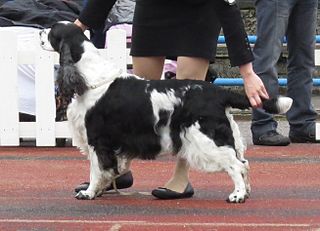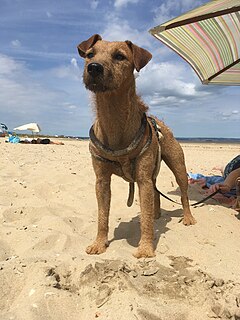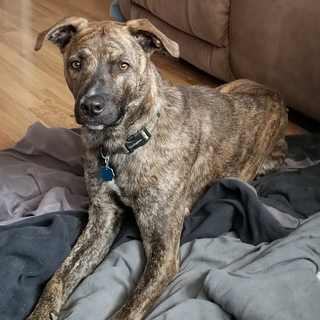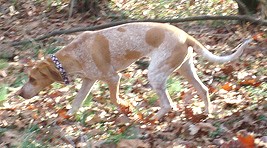Related Research Articles

The Catahoula Leopard Dog is an American dog breed named after Catahoula Parish, Louisiana. It became the state dog of Louisiana in 1979. It is recognized by the United Kennel Club (UKC) under the name Louisiana Catahoula Leopard Dog, and Catahoula Leopard Dog in the American Kennel Club (AKC) Foundation Stock Service. Both registries have assigned the breed a herding group designation. It has traditionally been used in hunting feral boars.

The English Springer Spaniel is a breed of gun dog in the Spaniel family traditionally used for flushing and retrieving game. It is an affectionate, excitable breed with a typical lifespan of twelve to fourteen years. They are very similar to the Welsh Springer Spaniel and are descended from the Norfolk or Shropshire Spaniels of the mid-19th century; the breed has diverged into separate show and working lines. The breed suffers from average health complaints. The show-bred version of the breed has been linked to "rage syndrome", although the disorder is very rare. It is closely related to the Welsh Springer Spaniel and very closely to the English Cocker Spaniel; less than a century ago, springers and cockers would come from the same litter. The smaller "cockers" hunted woodcock while the larger littermates were used to flush, or "spring", game. In 1902, The Kennel Club recognized the English Springer Spaniel as a distinct breed. They are used as sniffer dogs on a widespread basis. The term Springer comes from the historic hunting role, where the dog would flush (spring) birds into the air.

The German Wirehaired Pointer is a medium to large-sized griffon type breed of dog developed in the 19th century in Germany for hunting. It became a leading gun dog in Germany in the later part of the 20th century. It is the result of the careful mixing and crossing of the Wirehaired Pointing Griffon, German Shorthaired Pointer, German Roughhaired Pointer, and the hunting Pudelpointer in the late 19th century.

Gun dogs, or bird dogs, are types of hunting dogs developed to assist hunters in finding and retrieving game, usually quail, dove, or duck. Gun dogs are divided into three primary types: retrievers, flushing dogs, and pointing breeds.
Pointing dogs, sometimes called bird dogs, are a type of gundog typically used in finding game. Gundogs are traditionally divided into three classes: retrievers, flushing dogs, and pointing breeds. The name pointer comes from the dog's instinct to point, by stopping and aiming its muzzle towards game. This demonstrates to the hunter the location of their quarry and allows them to move into gun range. Pointers were selectively bred from dogs who had abundant pointing and backing instinct. They typically start to acquire their hunting instincts at about 2 months of age.

The Finnish Spitz is a breed of dog originating in Finland. The breed was originally bred to hunt all types of game from squirrels and other rodents to bears. It is a "bark pointer", indicating the position of game by barking, and drawing the game animal's attention to itself, allowing an easier approach for the hunter. Its original game hunting purpose was to point to game that fled into trees, such as grouse, and capercaillies, but it also serves well for hunting elk. Some individuals have even been known to go after a bear. In its native country, the breed is still mostly used as a hunting dog. The breed is friendly and in general loves children, so it is suitable for domestic life. The Finnish Spitz has been the national dog of Finland since 1979.

The Drentsche Patrijshond is a versatile spaniel-type hunting dog from the Dutch province of Drenthe. Called the Dutch Partridge Dog in English, approximately 5,000 dogs are registered with the breed club in the Netherlands, and breed clubs operate in Belgium, Denmark, Scandinavia and North America. The Drentsche Patrijshond bears some resemblance to both spaniel and setter types of dog. An excellent pointer and retriever, this dog is often used to hunt fowl and adapts equally well to the field or marshes.

Fell terrier refers to a regional type of long-legged working terrier, not a specific breed of dog.

The Pointer, sometimes called the English Pointer, is a medium-sized breed of pointing dog developed in England. Pointers are used to find game for hunters, and are considered by gundog enthusiasts to be one of the finest breeds of its type; however, unlike most other pointing breeds, its purpose is to point, not retrieve game.

The Small Münsterländer is a versatile hunting-pointing-retrieving dog breed that reached its current form in the area around Münster, Germany. The Large Münsterländer is from the same area, but was developed from different breeding stock and is not related as the names would suggest. Small Münsterländers bear a resemblance to both spaniels and setters but are more versatile while hunting on land and water. The Small Münsterländer is recognized by the Fédération Cynologique Internationale under Group 7, Section 1.2, Continental Pointing Dogs of Spaniel type, by the American Kennel Club as a Foundation Stock Service breed, and by The Kennel Club and the United Kennel Club as a gun dog. It is related to the Epagneul Français and the Drentsche Patrijshond.

The Mountain Cur is a type of working dog that is bred specifically for treeing and trailing small game, like squirrel and raccoons. They are also used for hunting and baying big game like bear and wild boar as well as being an all-purpose farm dog. Curs are a member of the Hound group, and the Mountain Cur is one of several varieties of cur. It can also be used as a water dog. Mainly bred in Ohio, Kentucky, Virginia, and Tennessee, it has been registered with the United Kennel Club since 1998. The Mountain Cur Breeder's Association was formed in 1957.

A feist is a small hunting dog, descended from the terriers brought over to the United States by English miners and other working-class immigrants. These terriers probably included crosses between the Smooth Fox Terrier, the Manchester Terrier, and the now-extinct English White Terrier. These dogs were used as ratters, and gambling on their prowess in killing rats was a favorite hobby of their owners. Some of these dogs have been crossed with Greyhounds, Whippets or Italian Greyhounds, and Beagles or other hounds - extending the family to include a larger variety of purpose than the original ratter, or Rat Terrier.

The West Siberian Laika or WSL, is a breed of hunting dog and a breed of spitz type. Russian publications indicate that the term West Siberian Laika loosely applied to hunting dogs originating with the Mansi and Khanty people in Ural and West Siberia, but there were no standards or registrations of WSL as such until 1930. Then WWll disrupted it for a while, but systematic breeding with registrations resumed after the war ended, in 1946. This was the time the breed began taking modern shape. Before that hunters only knew of Mansi Laika and Khanty Laika. In early 1960 many hunters in Ural still preferred the term Mansi Laika, when speaking of West Siberian Laika. In Russian language, the term Laika originated from the word layat that means to bark. The word Laika simply means barker. Any hunting Laika is a bark pointer. It is a versatile dog depending on use and environment, but in certain parts of the country they have become more specialized.

The Treeing Feist is a breed of feist from the Southeastern United States. Originally considered a single breed, the Mountain Feist is now considered a separate breed with both being separately recognized by the United Kennel Club.

The Drever is a breed of dog, a short-legged scenthound from Sweden used for hunting deer and other game. The Drever is descended from the Westphalian Dachsbracke, a type of German hound called Bracke. The breed name Drever was chosen through a contest in 1947.
The Treeing Cur is a breed of dog that originated in the mid-west and was first recognized by United Kennel Club on November 1, 1998, due to the efforts of Alex and Ray Kovac. "Most Cur breeders were not well off and so they required a dog that could serve multiple purposes: hunter, guardian, and stock dog. The result was the Treeing Cur, which is the most varied in size and colors of the Cur breeds", according to United Kennel Club.They are primarily used to tree squirrels, raccoons, opossum, wild boar, bears, mountain lion, bobcat as well as to hunt big game.

The English Coonhound, also referred to as the American English Coonhound or the Redtick Coonhound, is a breed of coonhound that originated in and is typically bred in the Southern United States. It is descended from hunting hounds, especially foxhounds, brought to America by settlers during the 17th and 18th centuries. The breed's first recognition came from the United Kennel Club in 1905 as the English Fox and Coonhound. Further recognition has been granted in recent years by the American Kennel Club, first in the Foundation Stock Service and in 2011 as a fully recognized member of the hound group.

Russo-European Laika is the name of a breed of hunting dog that originated in the forested region of northern Europe and Russia, one of several breeds developed from landrace Laika dogs of Spitz type. The Russo-European Laika itself dates to a breeding program begun in 1944 by E. I. Shereshevsky of the All-Union Research Institute for the Hunting Industry, in Kalinin Province.

The Westphalian Dachsbracke is a small, short-legged scenthound, a breed of dog originating in Westphalia, a region of Germany. The Westphalian Dachsbracke was used in Sweden to develop the Drever.
The German Hound is a breed of dog originating in Westphalia, a region of Germany. The German Hound is of the scenthound type, used for hunting both large and small game.
References
- 1 2 3 4 5 Morris, Desmond (2001). Dogs: the ultimate guide to over 1,000 dog breeds. North Pomfret, VT: Trafalgar Square Publishing. pp. 225–226. ISBN 1-57076-219-8.
- 1 2 3 4 Mehus-Roe, Kristin (2005). The original dog bible: the definitive source for all things dog. Irvine, CA: Bow Tie Press. p. 349. ISBN 1-931993-34-3.
| | This dog-related article is a stub. You can help Wikipedia by expanding it. |